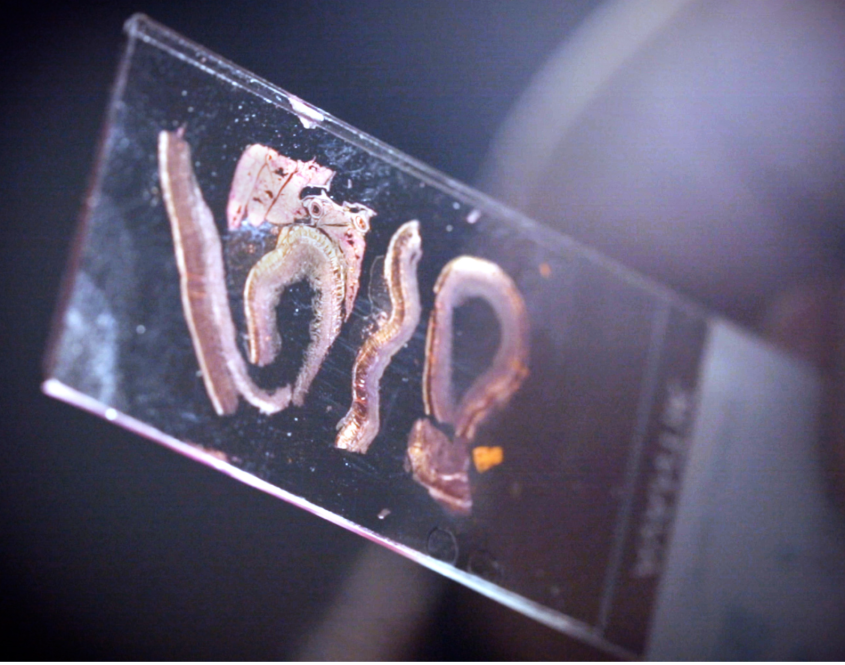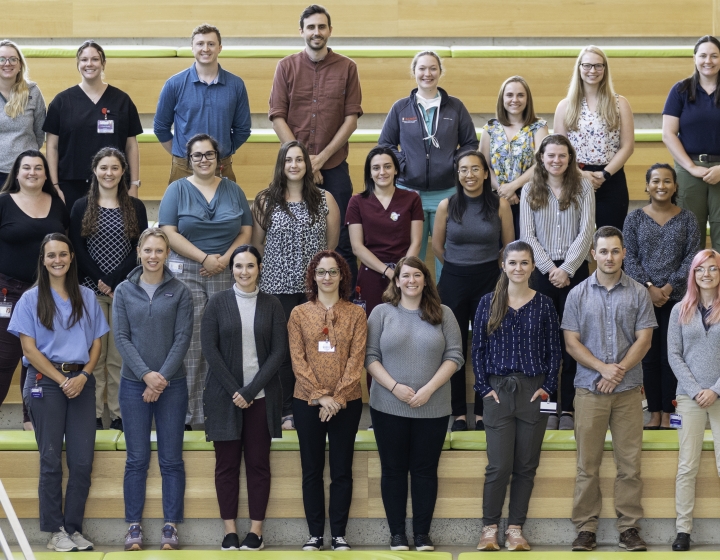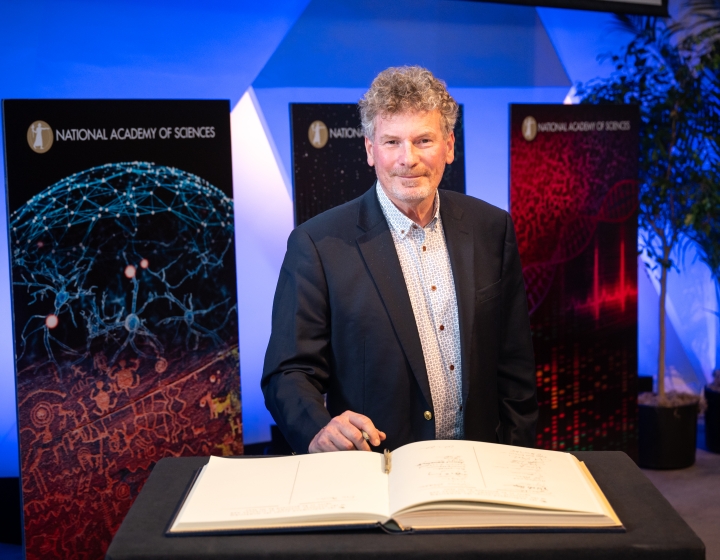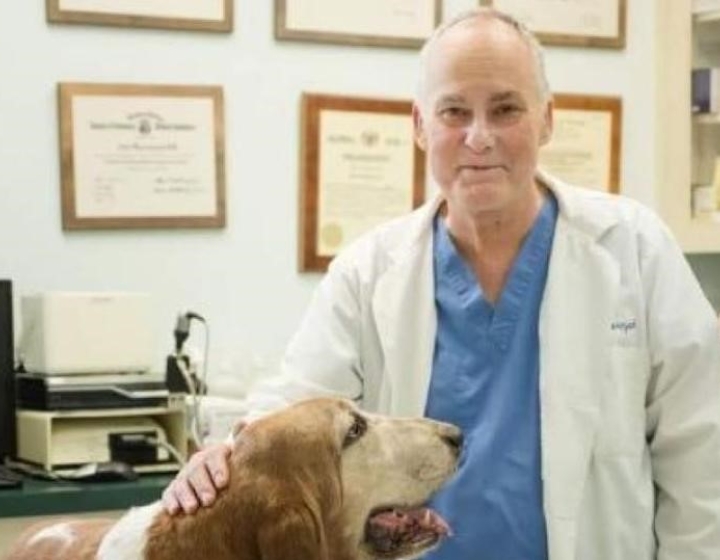Veterinary pathologists bolster New York crime-fighting efforts

slide from microscope
Note: This news item features content from another page. View the featured content for this news item.
In animal cruelty cases, it’s important for the sake of the animals – and for society – that someone is there to reveal truth and serve justice. Sean McDonough is one of those people.
In 2012, a 12-year-old girl in Orleans County reported she had witnessed a man kick a kitten to death in the parking lot of the apartment complex where she lived. The man, who lived at the complex with his girlfriend, claimed the kitten had fallen from a tree and died, and he was simply moving it out of the way.
McDonough, associate professor of veterinary pathology, conducted the necropsy at Cornell University’s Animal Health Diagnostic Center, one of a few labs in New York state that perform post-mortems on animals. Based on his findings, Orleans County District Attorney Joseph Cardone took the case to trial, at which McDonough testified.
When cats fall, most commonly from high-rise buildings, there is a pattern of injuries, McDonough said. They spread their legs and their fur slows the fall, and they tend to land horizontally on their feet, at times breaking limbs, with contusions on their undersides, possibly bruising or breaking their chins.
“The pattern and the types of injuries [in the kitten] were not compatible with falling from a height, but they were compatible with being struck with a heavy object or being kicked,” at least twice, McDonough said. Based on his testimony, the jury found the defendant guilty and the judge sentenced him to two years in state prison, due to a felony animal abuse charge and because he committed the act in front of a minor.
Even in heinous crimes, a pathologist’s job is not to advocate for one side or the other.
“I am not there to convict a guilty party; I am not there to ensure an innocent person goes free,” McDonough said. “I am there to help the court understand what happened to the animal, and they decide whether or not a crime was committed.”
In legal cases involving an animal’s death, necropsy reports provide invaluable information to district attorneys, juries and judges.
They also give voice to silent victims: the animals themselves.
When people commit deadly crimes against animals, the corpse has a tale to tell. It’s a veterinary pathologist’s job to translate that story.
Providing expertise
Starting in the early 1980s, experts pointed to a strong link between harming animals and human violence, which has raised the stakes for pursuing animal abuse crimes. Cornell’s Animal Health Diagnostic Center (AHDC) currently employs eight pathologists. Their findings help a district attorney decide if a case warrants prosecution, and they are used as evidence in a plea bargain or trial. The pathologists provide expert testimony to help a jury determine if a death resulted from neglect or whether it was intentional – the difference between a misdemeanor and a felony. And knowing how an animal died helps a judge determine a sentence.
Carissa Danesi, assistant district attorney for Nassau County, tried a case in February 2017 in which an emaciated pit bull froze to death outdoors. Andrew Miller, assistant professor of anatomic pathology with a specialty in neuropathology at AHDC, conducted the post-mortem exam and testified at the trial.
Miller described the contents of the dog’s stomach at the time of death for the court. “The animal had been starving to the point where she was eating wood and plastic to try and sustain herself; clearly that didn’t work,” Danesi said.
The jury also saw Miller’s photographs of the dog, which revealed how shriveled the animal had become when she died. The jury found the owner guilty, and the judge ordered an animal ban that prohibits him from owning any pets and sentenced him to probation. “I was asking for jail,” Danesi said.
Without an exam, it’s almost impossible to know what happened when an animal dies. “The necropsy report completes the narrative for us,” Danesi said.
Most animal abuse cases are settled out of court, but when Cornell pathologists testify at a trial, hearing forensic evidence from the person who performed the necropsy adds credibility and clarifies the events in a case, Danesi said.
“Even being able to call Cornell and just ask, ‘What does this mean? How do I explain this to a judge or a jury in terms that they can understand?’ This is extremely helpful,” Danesi said.
Rising caseloads
When McDonough started working at Cornell in 1997, AHDC pathologists did not do forensic post-mortem exams, aside from an occasional insurance case, such as when a horse died. Pathologists weren’t trained in forensic pathology. There was no formal training, a void that exists to this day, and something McDonough would like to change. In his first year at Cornell, McDonough trained himself and handled three forensic pathology cases.
“It slowly became known that I was willing to do these cases, and so through word-of-mouth networking, more and more cases were sent here,” McDonough said.
Now, all eight AHDC pathologists routinely carry out forensic exams as part of their duties.
“Our mission is to support animal health in the state and beyond, and we do that through testing specimens of all animal species for various diseases – mostly infectious, but also hormonal and metabolic diseases, or poisonings,” said François Elvinger, AHDC director.
Forensic cases with legal implications fall under that general domain. Overall, the pathology unit works on more than 10,000 cases a year, with close to 2,000 necropsies. Between April 2017 and March 2018, 151 of those necropsies had legal implications. Though they account for a small percentage of the caseload, legal forensic cases take much more time than the average nonlegal case because of the documentation required and the need to interact with the district attorney and testify in court.
The animal abuse-human abuse connection
The increase in the number of forensic cases the center receives is due in part to growing awareness of the relationship between animal abuse and crimes against humans.
“The truth of the matter is, if you look at just about every single mass murderer, it starts out with harming a vulnerable little animal. And there are studies that indicate people who are harming animals in a home, they are also harming their children and they are harming their spouses,” said P. David Soares, Albany County district attorney. “[Interest in these cases] is not just … my personal affection for my furry friends. It’s the fact that an individual who would prey on a vulnerable animal is also preying on vulnerable people.”
Recognition of this link between human and animal abuse has highlighted the societal importance of seeking justice against those who commit crimes against animals. It has helped spur a slowly growing system for investigating and prosecuting these crimes, though more training, expertise and funds are needed. An increasing number of law enforcement departments across the state offer trainings to police on identifying potential acts of animal cruelty. District attorney offices, like the one in Nassau County, have investigators dedicated to animal crimes. Though rare, there are veterinarians trained in forensics. And staff in animal shelters and humane societies across the state have their ears and eyes tuned to spot abuse and report cases when they see something suspicious.
“I don’t know if it’s necessarily happening more, but I do think there’s more awareness and more reporting,” Danesi said, of crimes against animals.
Determining cause of death
It takes a team of specialists to successfully pursue justice. Police officers, detectives, staff at humane organizations, district attorneys, judges, veterinarians and veterinary forensic pathologists at AHDC all play a role.
In New York state, humane societies and organizations are often authorized to investigate animal cruelty allegations, and some of them employ forensic veterinarians. But it’s up to the pathologist to determine or verify the cause of death.
Their report includes macroscopic findings – what they can see with their eyes – as well as the microscopic examination of tissues, fluids, toxins, infections and disease. The many photos they take can prove key in court.
The AHDC pathologists rotate weekly to do necropsies. In addition to their general training, each pathologist has a specialty area of expertise.
“Sean is very good at bullets and the traditional forensics,” said Beth Buckles, an anatomic pathologist and clinical associate professor of biomedical sciences. “We can all do that a little bit.” Buckles’ specialty is wildlife. “Every wildlife case is potentially a forensics case,” she said, noting that there are many laws regarding wildlife and marine mammals, and there is often little history that accompanies a wild animal when it comes to Cornell.
Buckles has examined dead roosters with wounds and scars that have helped break up several cockfighting rings in New York state.
The New York State Department of Environmental Conservation in Albany conducts forensic investigations on wildlife and sends animals to the AHDC for testing. In one instance, DEC biologists euthanized a deer that appeared ill. They suspected the animal had an infectious disease, but when Buckles examined the body, she discovered another cause for the animal’s listless behavior.
“I found an arrowhead sitting in its brain,” she said. “Someone had shot that animal illegally, out of season.”
Miller’s neuropathology expertise informed a case where a small-breed dog had died from head trauma. According to police, it had been thrown against a wall. When such history is provided, Miller said it is critical to conduct each necropsy in exactly the same manner and do an unbiased exam. He found hemorrhage of the skull and head muscles and damaged neurons.
“When compared with the history, the most likely cause was consistent with someone throwing it against a wall,” Miller said. “I testified and offered my expertise and opinions, and that led to a [conviction].”
Putting abusers on notice
“If you are prosecuting an individual for a crime, you are drawing attention to that individual and possibly preventing future crimes from happening,” Albany DA Soares said. Nobody knows how many animals have been spared due to these efforts.
“There’s a lot of value in [a pathologist’s forensic work], not just to the animals, but to the people who own those animals who may have also suffered trauma,” Miller said.
Pathologist McDonough testified in a case where he examined the body of a small terrier. The necropsy revealed a ruptured spleen, but upon further examination and looking at the history, he found patterns of abuse, including partially healed rib fractures and a scar from a prior incident where the owner claimed he had accidentally spilled boiling water on the animal while cooking.
“Well, accidents do happen, but when you start putting together all these events, it’s similar to the patterns they recognize in child abuse,” he said. McDonough filed a complaint, but the veterinarian vouched for the owner who denied wrongdoing. The case was not prosecuted.
“On the other hand,” McDonough said, “I think the individual is now on notice that someone is paying attention.”





